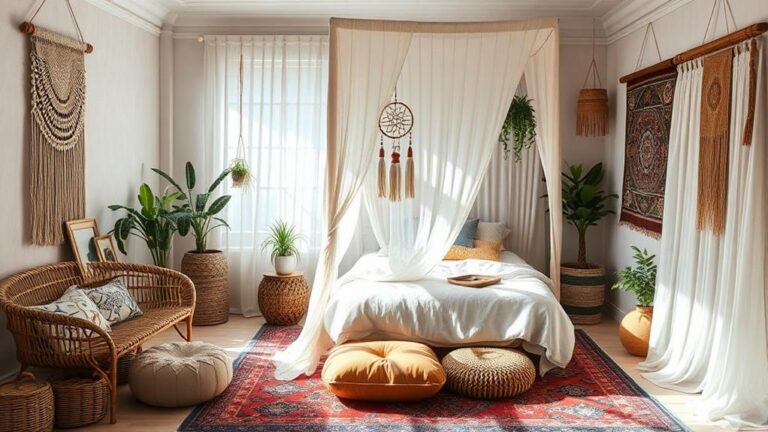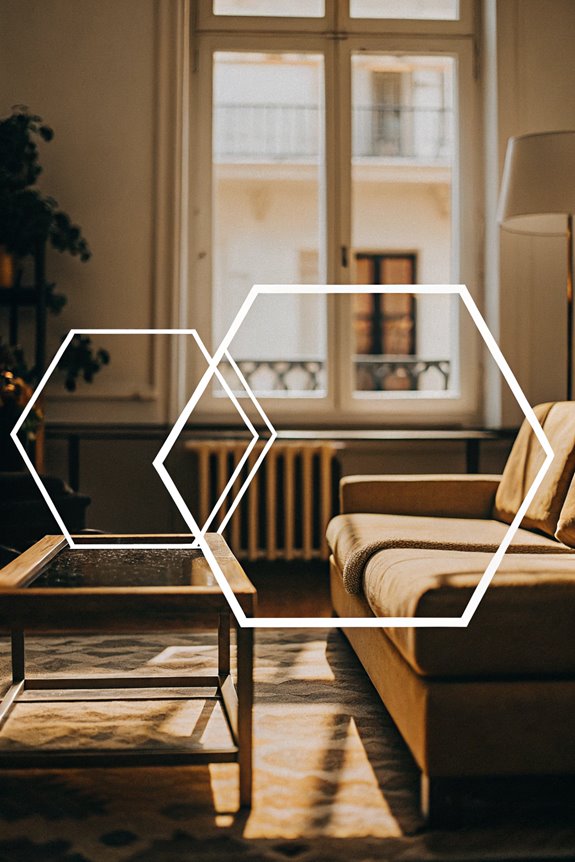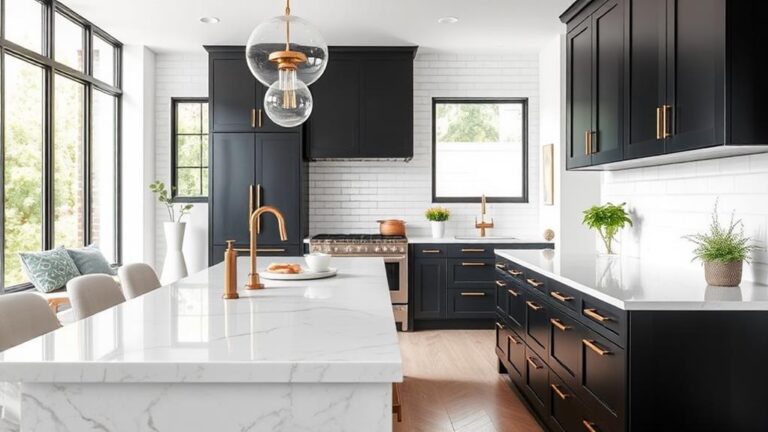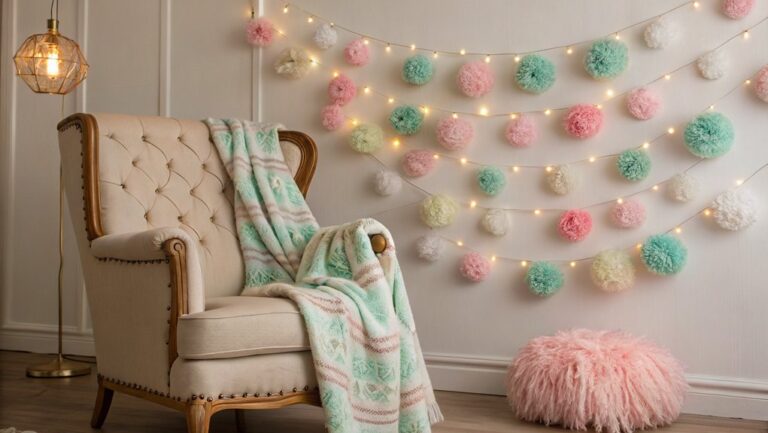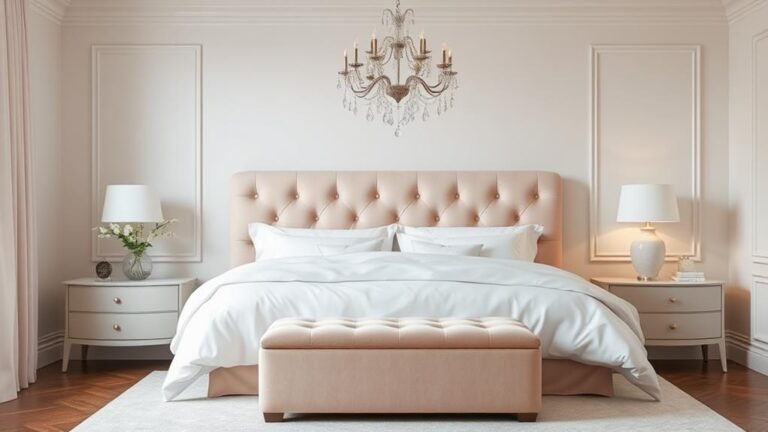In the domain of interior design, the living room serves as both a sanctuary and a canvas for personal expression. Traditional approaches are being challenged by a wave of unconventional ideas that promise to invigorate these spaces. From the audacious contrasts of bold color blocking to the serene vibes of minimalist Zen spaces, each concept redefines what a living room can be. Imagine sculptural seating that doubles as art or vertical gardens that bring the outside in. These innovative ideas not only transform aesthetics but also enhance functionality. Are you ready to explore how your living room can transcend the ordinary?
Bold Color Blocking
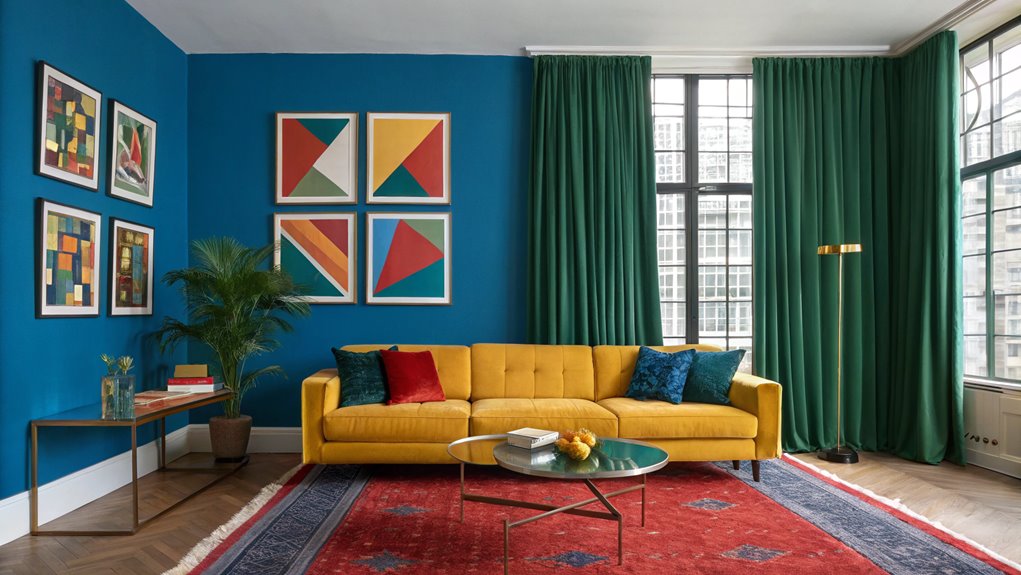
When it comes to revolutionizing your living room design, bold color blocking emerges as a dynamic strategy that commands attention and infuses energy into the space.
Embracing current color trends, this approach involves using contrasting hues in distinct sections to create visual harmony and dynamism. Paint techniques like geometric patterns or large-scale color zones can transform walls into canvases that reflect contemporary design sensibilities.
“Color blocking can redefine a space, offering an opportunity to merge artistic expression with modern aesthetics,” notes interior designer Jane Smith. By strategically selecting vibrant yet complementary shades, one can effectively delineate areas within a room, fostering both functionality and visual intrigue.
Adopting this trend not only modernizes interiors but also adds a personalized, innovative touch to any living room.
Eclectic Furniture Mix
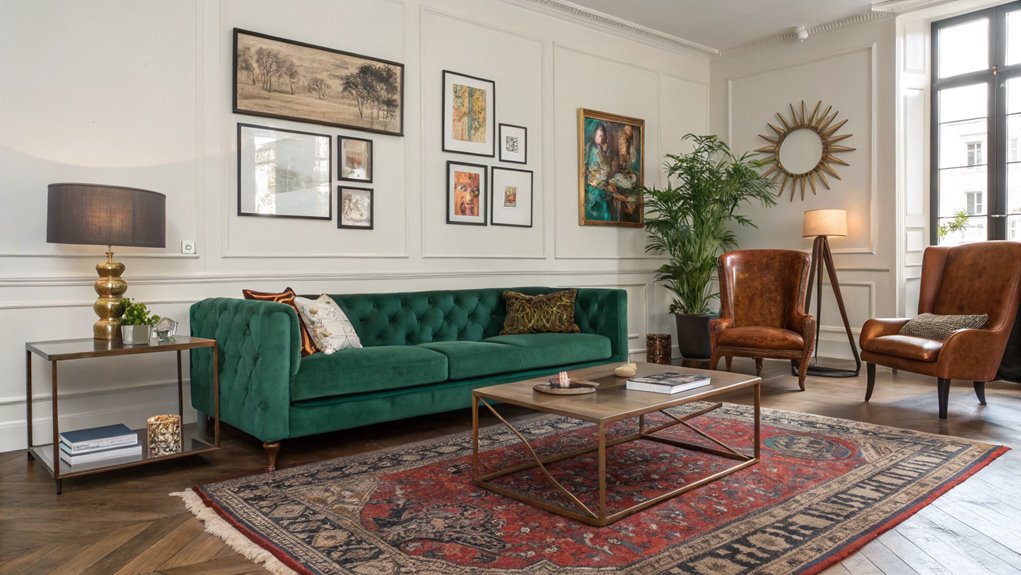
An eclectic furniture mix breathes individuality and character into a living room, seamlessly blending disparate styles to create a cohesive yet dynamic environment.
The key to achieving this balance lies in thoughtful furniture arrangement; juxtaposing vintage and contemporary pieces can infuse the space with a curated yet spontaneous feel. “Mixing various textures and materials adds visual depth,” suggests interior designer Maria Blake.
Decorative accents, such as bold throw pillows or unique artwork, further enhance the eclectic vibe, serving as focal points that tie the diverse elements together.
Consider, for example, a mid-century modern sofa paired with an industrial coffee table, complemented by colorful bohemian rugs.
This approach not only transforms the living space into an artistic haven but also encourages personal expression through design.
Statement Lighting Pieces
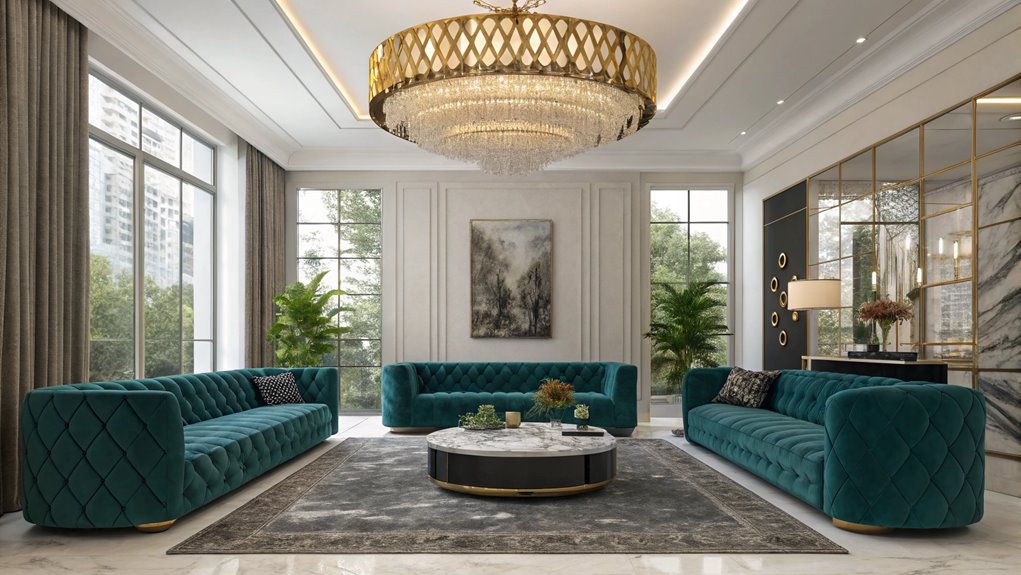
Lighting serves as both a functional necessity and a pivotal design element in any living room, with statement lighting pieces playing a transformative role.
Integrating bold lighting fixtures can redefine the aesthetic landscape, creating a focal point that captivates and inspires. Ceiling lamps, for example, offer both grandeur and innovation, seamlessly integrating artistry with utility.
“Statement lighting is the jewelry of a room,” notes interior designer Jane Collins, emphasizing its power to elevate ordinary spaces. Opt for sculptural designs or avant-garde installations to infuse character and depth. Consider materials like brushed metal or hand-blown glass to enhance texture and reflectivity.
Indoor Vertical Gardens
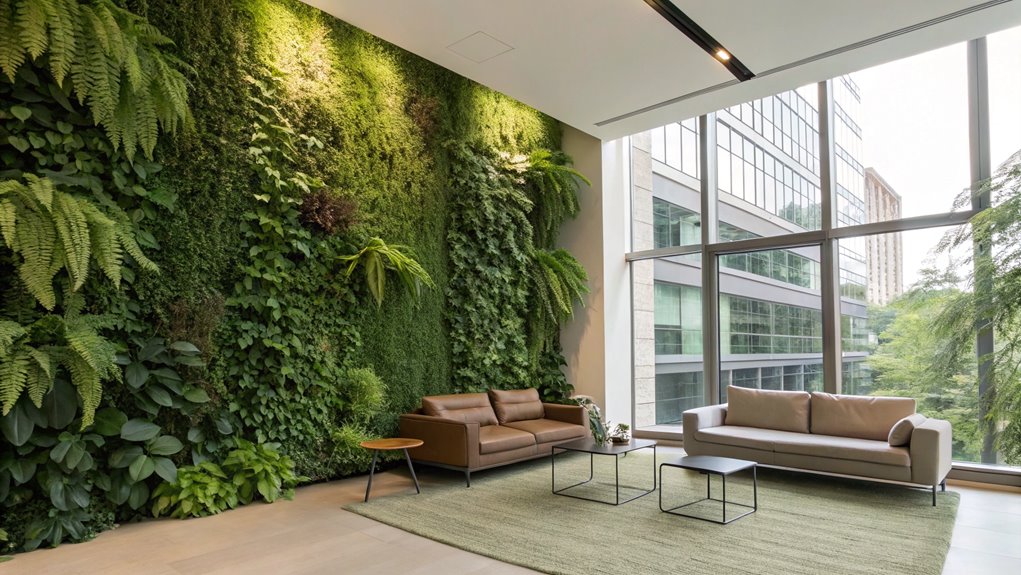
Among the myriad of ways to transform living spaces, indoor vertical gardens stand out for their unique ability to merge nature with interior design.
These innovative green walls not only enhance aesthetic appeal but also improve air quality, offering a sustainable solution for modern homes. According to landscape architect Jane Smith, “Living fences can redefine spatial dynamics, creating an invigorating ambiance that invigorates the senses.”
By utilizing modular systems, homeowners can customize plant arrangements, integrating ferns, succulents, or herbs to suit their personal style. For those seeking to maximize limited space, vertical gardens provide a lush, eco-friendly alternative to traditional potted plants.
This trend, endorsed by design experts, emphasizes biophilic design principles, reconnecting inhabitants with nature, while offering practical environmental benefits.
Floating Bookshelves
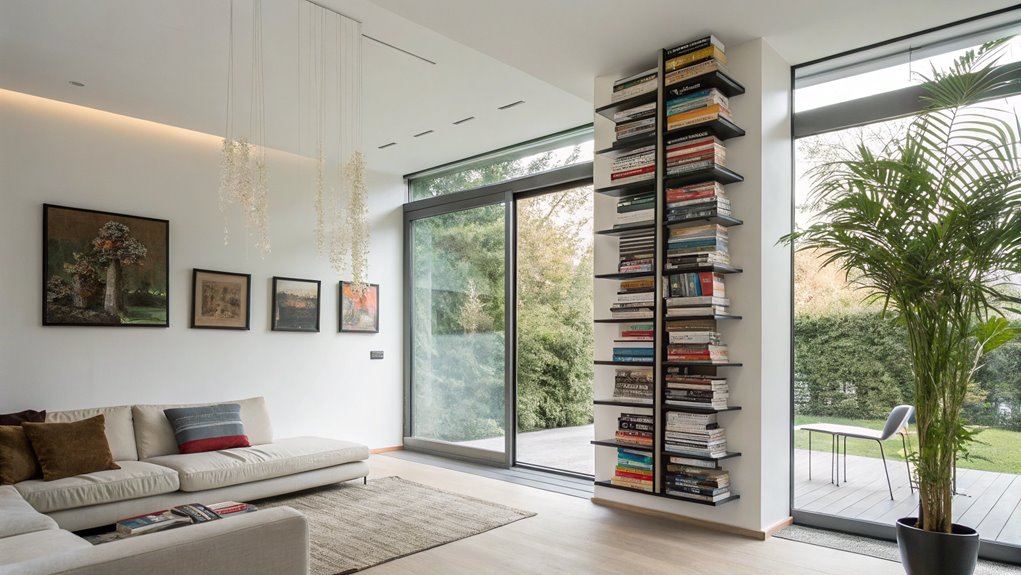
Floating bookshelves have emerged as a sophisticated design solution, offering both functionality and minimalist aesthetics to contemporary living rooms.
These innovative book storage options redefine shelf design by creating the illusion of books floating against the wall, thereby maximizing space and enhancing visual intrigue.
According to interior designer Emma Carter, “Floating bookshelves not only save floor space but also present a unique opportunity to showcase literary collections as artistic displays.”
The sleek, unobtrusive structure of these shelves integrates seamlessly into modern decor, allowing homeowners to maintain a clutter-free environment.
Retro-Inspired Decor

As homeowners seek to infuse their living spaces with personality and charm, retro-inspired decor emerges as an enchanting alternative to modern minimalist trends.
Retro furnishings, seamlessly blending nostalgia with contemporary flair, offer an enthralling aesthetic that speaks to innovation-hungry individuals.
Imagine a mid-century modern sofa, its sleek lines and rich upholstery resonating with the era’s iconic style.
Complementing this, vintage collectibles like rotary phones or classic record players can serve as focal points, imbuing the room with historical intrigue.
According to interior design expert Lisa Stevens, “Incorporating retro elements allows for a unique narrative within the home, where every piece tells a story.”
Geometric Wall Art
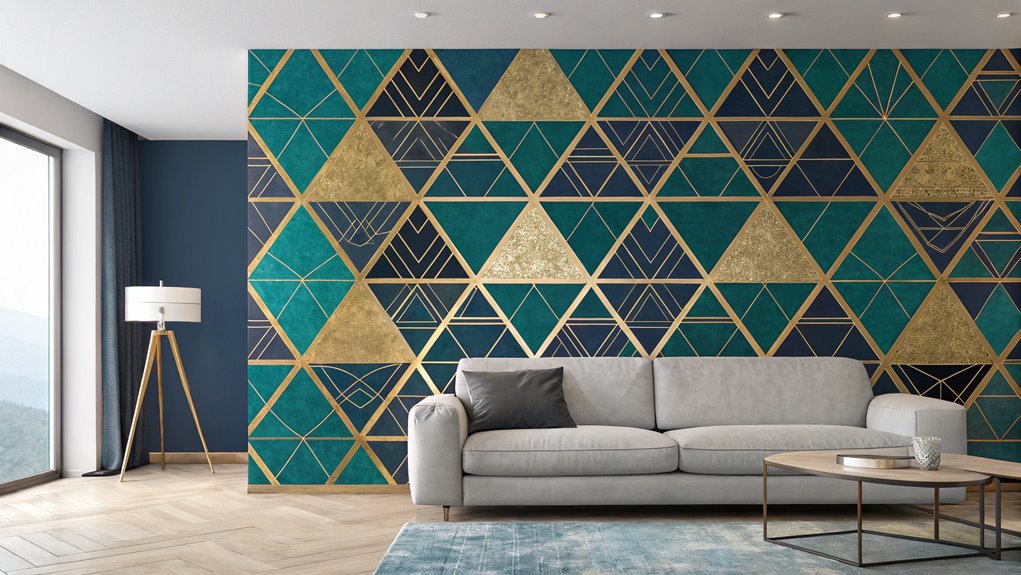
While modern design often favors simplicity, geometric wall art offers a sophisticated way to add visual interest and structure to a living room.
Wall murals, with their bold shapes and intricate patterns, provide an opportunity to transform a blank canvas into a dynamic focal point.
As interior designer Emma Callahan notes, “Geometric designs are timeless; they create movement and depth, inviting the eye to explore.”
Incorporating abstract paintings with geometric themes can further elevate the aesthetic, offering a balance of color and form that complements contemporary furnishings.
Investing in high-quality materials guarantees the longevity of these art pieces, allowing them to remain a vibrant part of your decor.
For those seeking to innovate, geometric art offers a refined, yet daring, decor solution.
Open Concept Layout
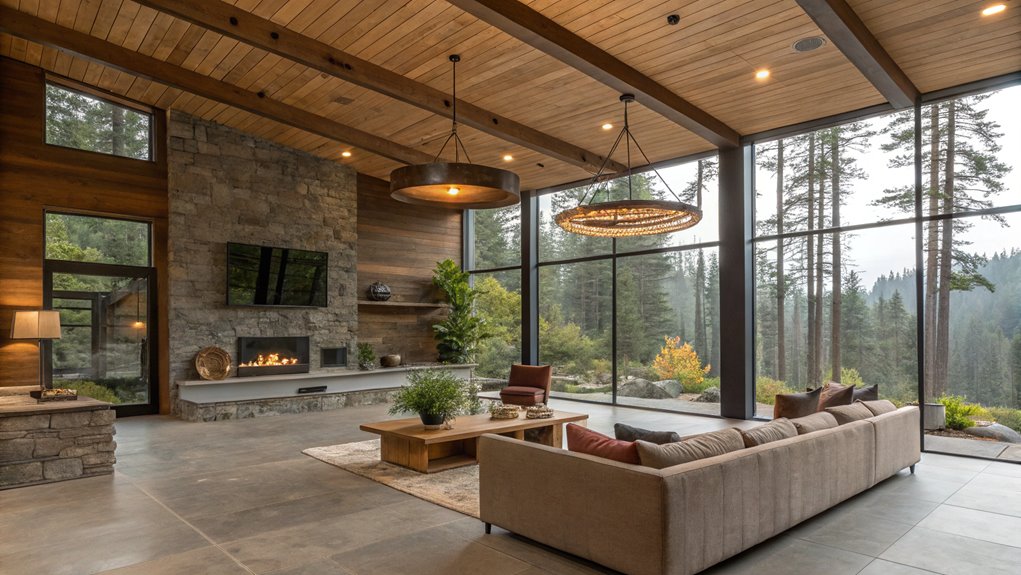
Building on the dynamic interplay of geometric wall art, an open concept layout can further enhance a living room’s sense of space and fluidity.
By eliminating unnecessary barriers, homeowners can seamlessly blend cozy nooks with spacious areas, creating a harmonious environment that encourages both relaxation and social interaction.
As interior designer Sarah Collins notes, “An open concept layout maximizes natural light and flow, offering a versatile canvas for personal expression.”
This approach allows for strategic zoning, where furniture arrangements subtly define distinct yet interconnected spaces.
For instance, a plush sectional can demarcate a lounging area, complemented by a strategically placed reading chair to carve out a cozy nook.
Such thoughtful design decisions foster a more inviting and functional living space, perfectly attuned to contemporary lifestyles.
Reclaimed Wood Accents
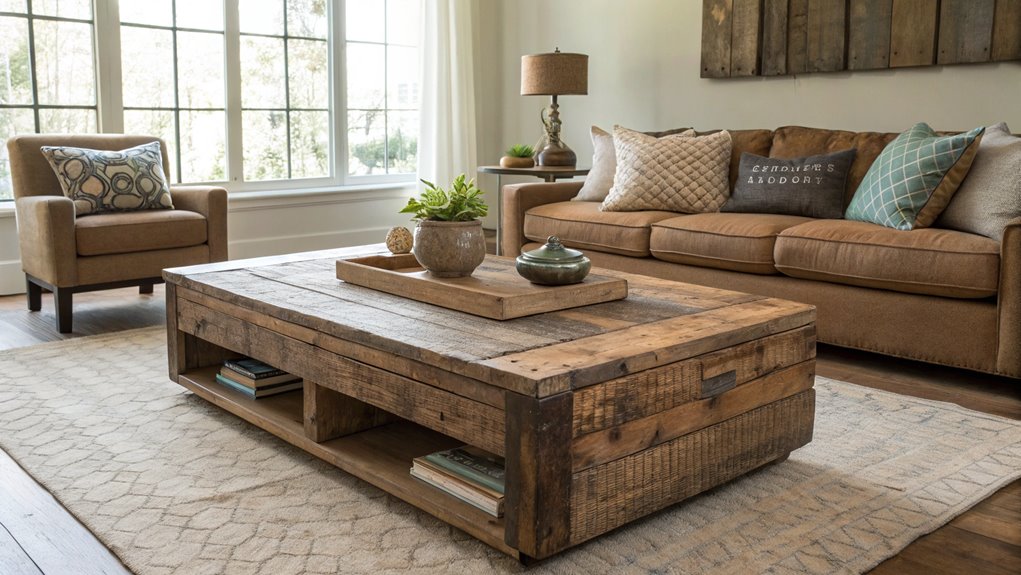
Introduce a touch of rustic charm and sustainability to your living room with reclaimed wood accents.
These elements not only celebrate the beauty of natural wood grain but also embody the principles of rustic decor, creating a warm and inviting atmosphere.
By integrating reclaimed wood, you can craft unique features such as accent walls, coffee tables, or shelving units that resonate with individuality and eco-consciousness.
“Reclaimed wood offers a distinctive character that new materials simply can’t replicate,” suggests interior designer, Emily Foster.
She adds, “Its history and imperfections tell a story, adding depth to any space.”
Consider pairing these accents with neutral color palettes to highlight the wood’s natural hues, or juxtapose with modern furnishings for a striking, innovative contrast.
Industrial Chic Elements

To achieve this look, consider leaving structural components such as beams exposed, thereby celebrating the beauty of architectural honesty.
Complement these with minimalist furniture to maintain balance.
Opt for neutral palettes, allowing the industrial features to stand as focal points.
According to Greene, “The key lies in restraint; too many elements can overwhelm, whereas strategic placement guarantees harmony and elegance.”
Maximalist Patterns

Shifting from the disciplined allure of industrial chic to the vibrant world of maximalist patterns invites an exploration of boldness and creativity.
Embracing pattern overload, maximalism defies minimalist constraints, weaving together extravagant colors and intricate designs.
Textile clash becomes an art form, as juxtaposing florals, geometrics, and stripes invigorates spaces with dynamic energy.
Interior designer Sarah Williams notes, “Maximalist patterns transform rooms into visual feasts, each element narrating a unique story.”
Consider pairing a damask wallpaper with a zigzagged upholstery to achieve an arresting aesthetic harmony.
The strategic use of disparate motifs elevates the sensory experience, as every piece contributes to an eclectic tapestry.
This approach not only challenges conventional decor norms but also elevates the living room into a personalized gallery of inspiration.
Vintage Rug Layering

Imagine stepping into a living room where layers of vintage rugs create a rich tapestry underfoot, each one telling a story of artistry and heritage.
This bold yet elegant approach enhances rustic decor and Bohemian style, adding warmth and character.
To master this technique, consider these steps:
- Select Contrasting Textures: Combine different materials to create visual interest and depth.
- Play with Patterns: Mix bold patterns with subtle designs for a harmonious blend.
- Vary Sizes: Use a large base rug with smaller rugs on top to define specific areas.
- Coordinate Colors: Guarantee a cohesive look by choosing complementary colors.
Interior designers like Jane Smith emphasize, “Layering vintage rugs is an art form, offering endless possibilities for personal expression in home decor.”
Minimalist Zen Space
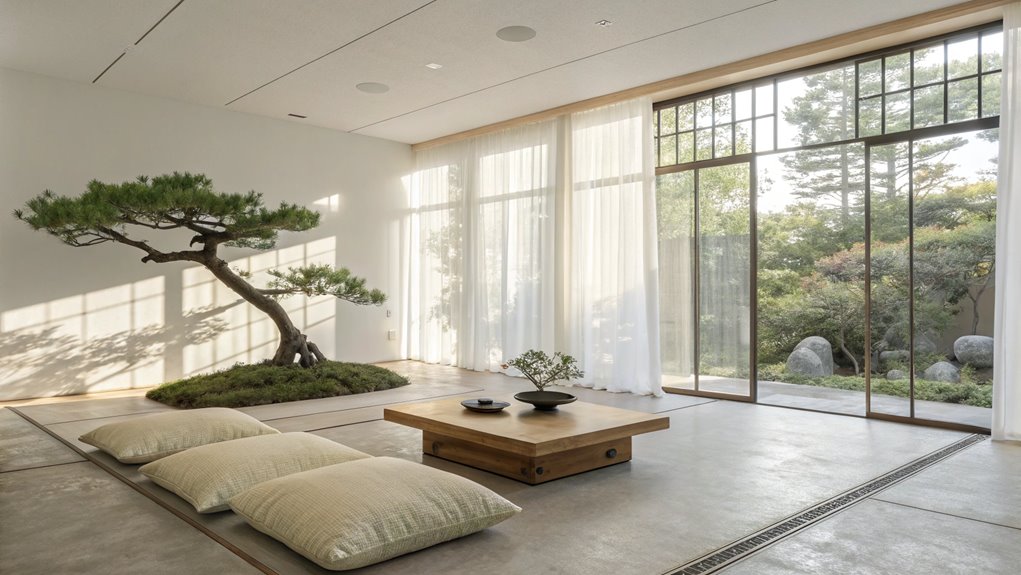
While vintage rug layering offers a dynamic and textured aesthetic, the Minimalist Zen Space embraces simplicity and tranquility, focusing on creating an environment that promotes peace and mindfulness.
This design philosophy prioritizes a calming atmosphere through the strategic use of neutral tones, uncluttered spaces, and natural materials like bamboo and stone. Expert designer, Keiko Yamamoto, suggests, “To cultivate a peaceful ambiance, limit furnishings to essentials, allowing open space to breathe.”
Incorporating elements such as a low-profile sofa or a single piece of statement art can enhance the overall tranquility without overwhelming the senses. The Minimalist Zen Space, with its serene palette and deliberate restraint, offers a harmonious retreat from daily chaos, providing an innovative sanctuary for reflection and relaxation.
Artistic Ceiling Designs
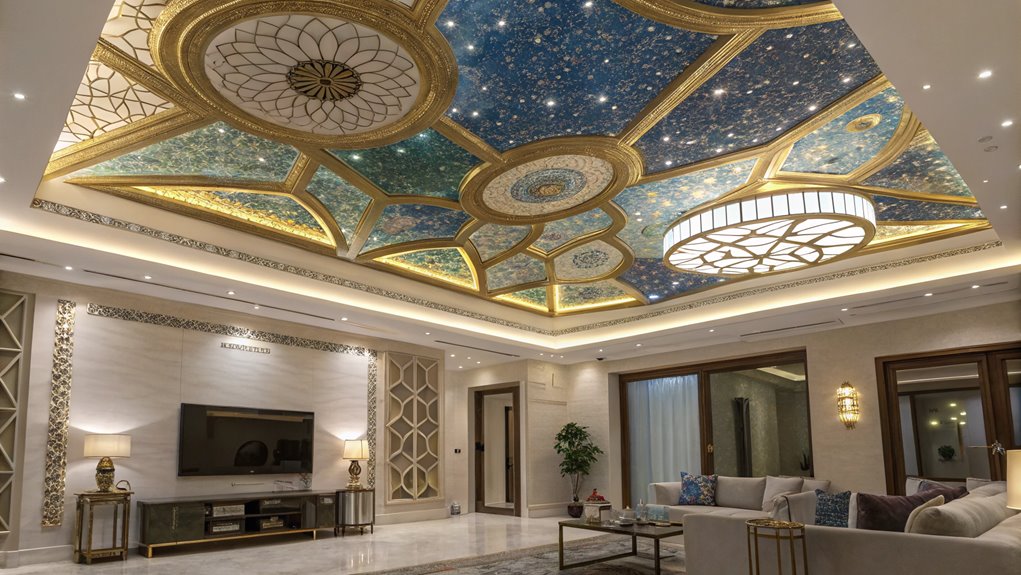
Artistic ceiling designs have emerged as a transformative element in modern living room aesthetics, offering a visually enchanting focal point that elevates the entire space.
By embracing creativity, homeowners can redefine their ceilings with dynamic options like ceiling murals and acoustic panels.
Here’s how:
- Ceiling Murals: These artistic renderings transform blank canvases into masterpieces, adding depth and character.
- Acoustic Panels: Beyond aesthetic appeal, these panels enhance sound quality, creating an immersive audio experience.
- Architectural Moldings: Incorporating intricate moldings can add historic charm and sophistication.
- LED Integrations: Utilizing LED lighting within ceiling designs introduces versatile ambiance control.
As interior designer Jane Smith suggests, “A thoughtfully designed ceiling can reshape a room’s entire atmosphere, offering both visual intrigue and functional benefits.”
These innovations allow living rooms to transcend traditional boundaries.
Curated Gallery Walls
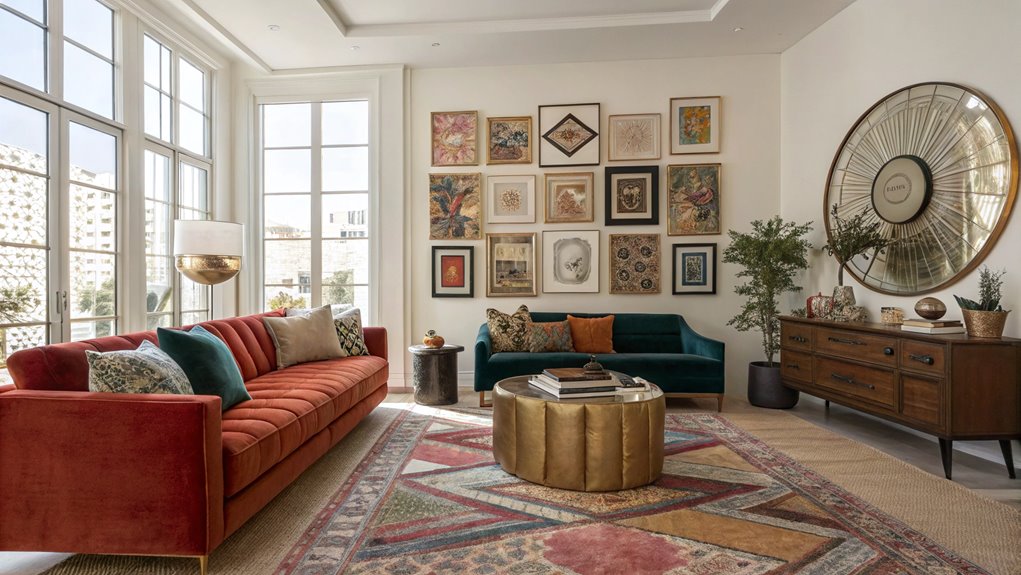
Curated gallery walls have become a hallmark of modern interior design, offering a personalized and dynamic way to showcase art and photography in living rooms.
By thoughtfully selecting frame styles and art pieces, homeowners can create a visual narrative that reflects their unique taste. “The secret to a striking gallery wall lies in the harmonious blend of various frame styles,” notes interior designer Emma Jacobs, emphasizing the importance of balance and cohesion.
Art pieces, ranging from bold abstract works to delicate sketches, can be arranged to create visual interest and depth.
Industry experts suggest mixing different sizes and orientations to achieve a layered effect. This innovative approach not only transforms dull walls but also elevates the entire aesthetic of the living room space.
Transparent Furniture
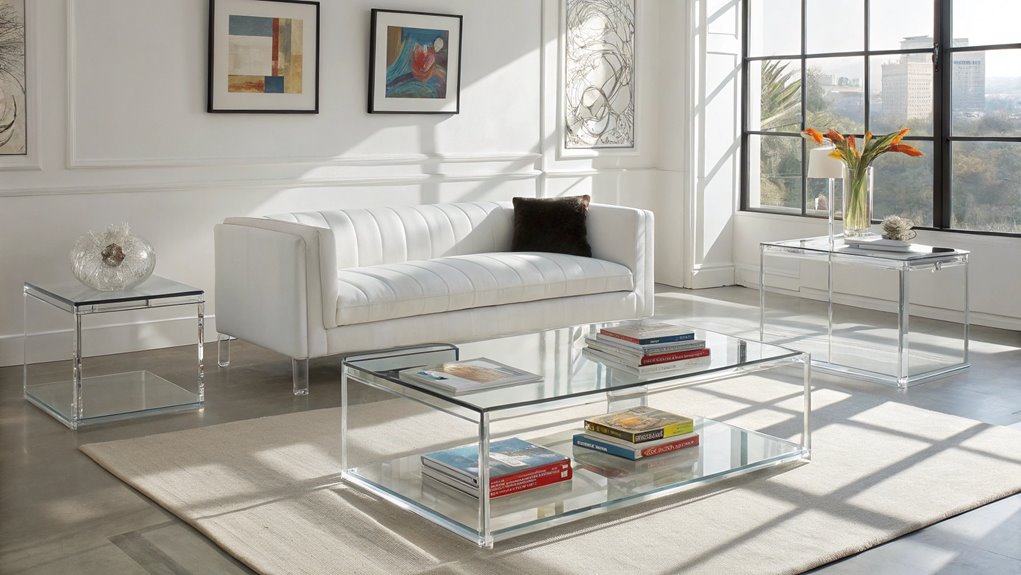
Incorporating transparent furniture into a living room design introduces an element of modern sophistication while maintaining an open and airy atmosphere.
This innovative approach utilizes clear tables and invisible chairs to create a seamless environment that maximizes space and light. Interior designer Jane Doe notes, “Transparent furniture can transform a room by eliminating visual clutter, allowing other design elements to shine.”
Consider these four benefits of transparent furniture:
- Illusion of Space: Clear tables and invisible chairs provide an unobstructed view, enhancing the perception of spaciousness.
- Versatility: These pieces complement various styles, from minimalistic to eclectic.
- Durability: Made from materials like acrylic or tempered glass, they offer robust longevity.
- Aesthetic Appeal: Their sleek lines and modern look appeal to contemporary tastes.
Unexpected Textiles
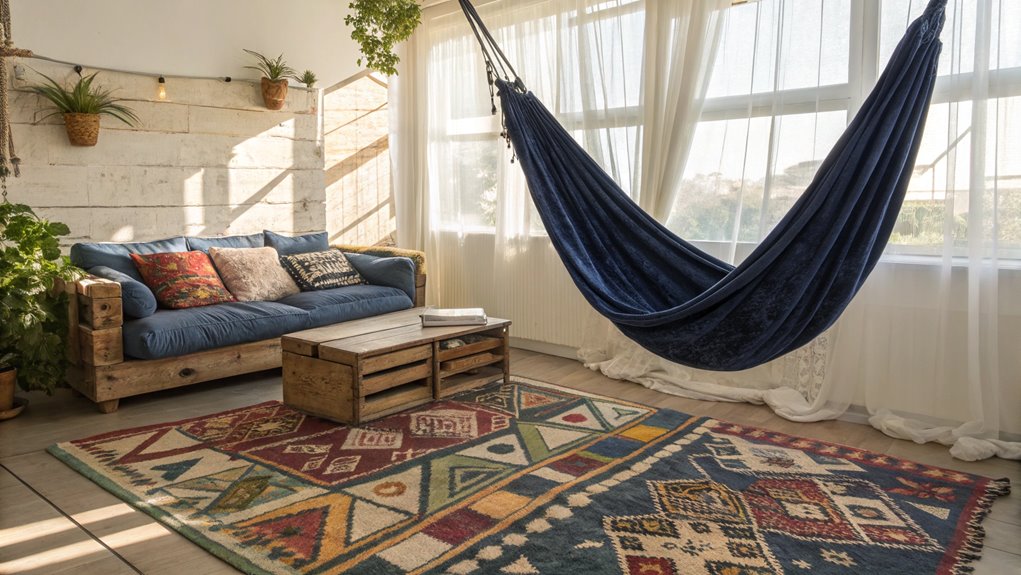
Textiles play a pivotal role in defining the character and comfort of a living room, and unexpected textiles can bring an invigorating twist to traditional design schemes.
Textile exploration involves embracing unconventional fabrics such as metallic threads or recycled materials, which can inject a sense of innovation and sustainability into your space.
Fabric manipulation techniques, like pleating or laser cutting, further enhance these materials, creating tactile interest and visual intrigue.
According to interior designer Emily Richards, “The integration of unique textiles allows for a dynamic interplay of texture and color, transforming any living area into an artistic expression.”
For those seeking to redefine conventional aesthetics, consider experimenting with patchwork leather or digitally printed silks to craft an avant-garde ambiance that reflects personal flair and creativity.
Sculptural Seating

While unique textiles can redefine a living room’s aesthetic, introducing sculptural seating takes spatial artistry to another level.
Sculptural chairs and artistic sofas are not mere furniture; they are statement pieces that redefine the room’s visual and functional dynamics. To integrate such pieces effectively, consider the following:
- Contrast and Balance: Pair bold sculptural chairs with understated decor to create harmony and focal interest.
- Functionality: Guarantee artistic sofas maintain comfort and usability, honoring both form and function.
- Material Exploration: Utilize diverse materials like metal, wood, or acrylic to enhance visual texture and intrigue.
- Spatial Arrangement: Position sculptural seating as central elements to anchor the room’s design narrative.
As designer Jane Doe notes, “Sculptural seating transforms living spaces into galleries of personal expression.”
Nature-Inspired Palettes
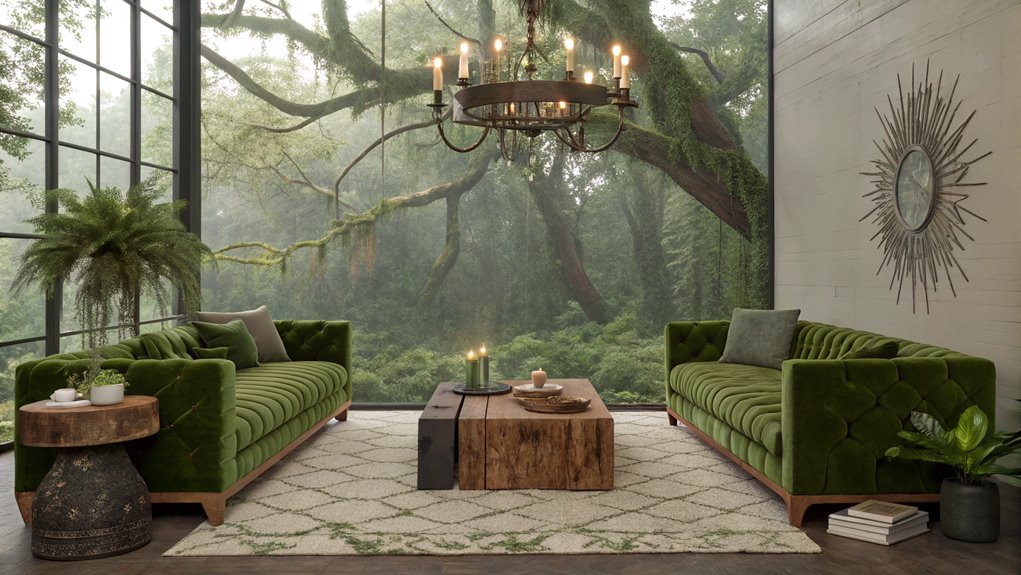
Nature-inspired palettes offer an unparalleled sense of tranquility and connection to the outdoors, seamlessly integrating organic elements into interior design.
By utilizing earth tones and natural hues, designers create living spaces that evoke the serenity of a forest or the calm of a beach. These palettes, characterized by muted greens, rich browns, and soft beiges, are not only visually soothing but also versatile, complementing various textures and materials.
Interior designer Emma Lawson suggests, “Incorporating natural hues in your living room can transform the space into a sanctuary, fostering relaxation and creativity.” For instance, pairing a sandy beige sofa with olive green accents can evoke a coastal retreat.
Such combinations allow homeowners to embrace innovation while maintaining a timeless, grounded aesthetic.
Futuristic Technology Integration
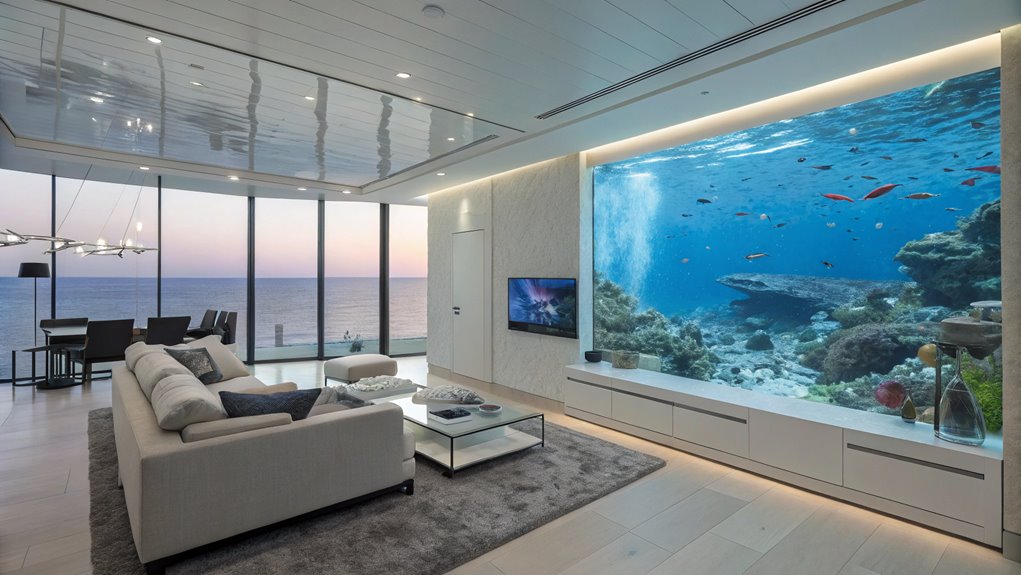
As the boundaries between technology and daily living become increasingly blurred, integrating futuristic technology into the living room offers an exciting opportunity to redefine traditional spaces.
Smart homes are evolving, allowing homeowners to infuse their living areas with cutting-edge innovations. By embracing virtual reality and other advanced technologies, one can create an immersive environment that enhances both relaxation and entertainment.
Here are four innovative ways to transform your living room:
- Smart Lighting: Utilize voice-controlled LED systems for customizable ambiance.
- Virtual Reality Corners: Designate spaces for VR experiences, enhancing interactive gaming or immersive cinema.
- Integrated Audio Systems: Employ wireless, multi-room audio for seamless sound experience.
- Augmented Reality Decor: Use AR to visualize and modify interior design elements dynamically.
Experts suggest that these integrations not only offer convenience but also redefine how we experience home life.
Multi-Functional Zones
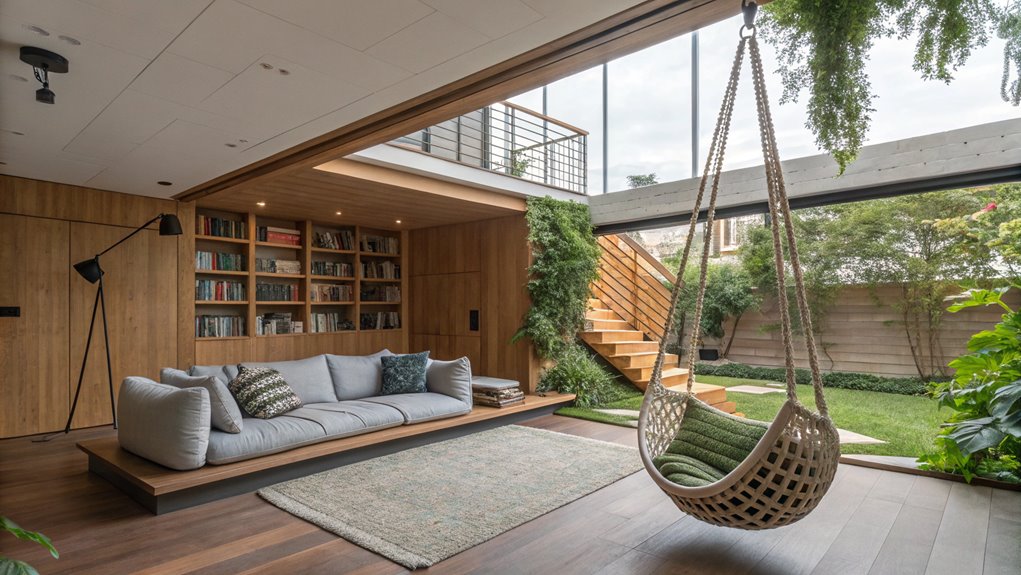
Versatility is key in modern living room design, where multi-functional zones are becoming essential. By integrating various living zones within a single space, homeowners can achieve not only aesthetic diversity but also functional practicality. Imagine a cozy nook for reading seamlessly shifting into a vibrant area for entertainment, providing a dynamic environment that caters to diverse activities.
“Multi-functional zones allow us to maximize every square foot,” notes interior designer Laura Bennett, emphasizing the importance of adaptable spaces in contemporary homes.
Utilizing innovative furniture solutions, such as modular seating or foldable tables, facilitates the creation of these versatile areas. Additionally, strategic use of lighting and color can delineate different zones, enhancing the room’s overall cohesion.
This approach guarantees that living rooms meet the evolving needs of modern households, and also, the use of space is optimized to make the most of the available area, thus making certain living rooms remain functional and efficient.

